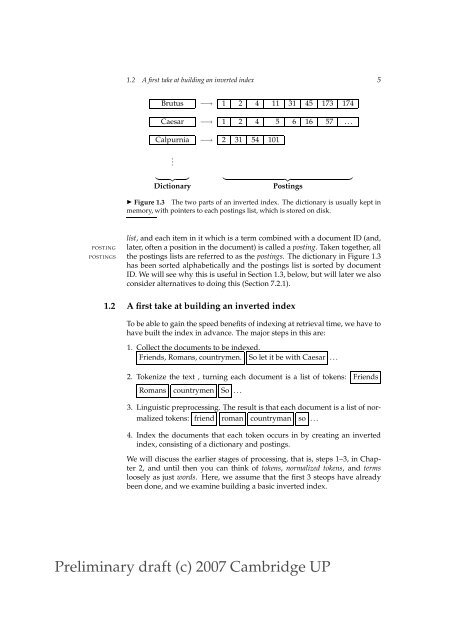Preliminary draft (c) 2007 Cambridge UP - Villanova University
Preliminary draft (c) 2007 Cambridge UP - Villanova University
Preliminary draft (c) 2007 Cambridge UP - Villanova University
You also want an ePaper? Increase the reach of your titles
YUMPU automatically turns print PDFs into web optimized ePapers that Google loves.
1.2 A first take at building an inverted index 5<br />
Brutus −→ 1 2 4 11 31 45 173 174<br />
Caesar −→ 1 2 4 5 6 16 57 . . .<br />
Calpurnia −→ 2 31 54 101<br />
.<br />
} {{ } } {{ }<br />
Dictionary<br />
Postings<br />
◮ Figure 1.3 The two parts of an inverted index. The dictionary is usually kept in<br />
memory, with pointers to each postings list, which is stored on disk.<br />
POSTING<br />
POSTINGS<br />
list, and each item in it which is a term combined with a document ID (and,<br />
later, often a position in the document) is called a posting. Taken together, all<br />
the postings lists are referred to as the postings. The dictionary in Figure 1.3<br />
has been sorted alphabetically and the postings list is sorted by document<br />
ID. We will see why this is useful in Section 1.3, below, but will later we also<br />
consider alternatives to doing this (Section 7.2.1).<br />
1.2 A first take at building an inverted index<br />
To be able to gain the speed benefits of indexing at retrieval time, we have to<br />
have built the index in advance. The major steps in this are:<br />
1. Collect the documents to be indexed.<br />
Friends, Romans, countrymen. So let it be with Caesar . . .<br />
2. Tokenize the text , turning each document is a list of tokens: Friends<br />
Romans countrymen So . . .<br />
3. Linguistic preprocessing. The result is that each document is a list of normalized<br />
tokens: friend roman countryman so . . .<br />
4. Index the documents that each token occurs in by creating an inverted<br />
index, consisting of a dictionary and postings.<br />
We will discuss the earlier stages of processing, that is, steps 1–3, in Chapter<br />
2, and until then you can think of tokens, normalized tokens, and terms<br />
loosely as just words. Here, we assume that the first 3 steops have already<br />
been done, and we examine building a basic inverted index.<br />
<strong>Preliminary</strong> <strong>draft</strong> (c)<strong>2007</strong> <strong>Cambridge</strong> <strong>UP</strong>



